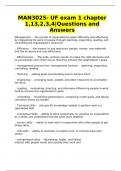Plato’s Allegory of the Cave
Question: What is reality?
Plato 2400 years ago: Prisoners are chained in a cave. They are unable to turn their heads
and only see objects by shadows on the wall they are facing. Once one of the prisoners is
released. He returns to the cave, but as he is no longer used to the darkness he can’t see
the shadows on the wall that well anymore. The others think the journey made him stupid
and blind. They do not want to be freed by him anymore.
Plato compares this to what it is like to be a philosopher trying to educate the public. People
are comfortable in their ignorance and sometimes even hostile to anyone who has a view
different from their reality.
Allegory is connected to theory of forms = like the shadows on the wall, things in the physical
world are flawed reflections of ideal forms.
Research fundamentals
1. What is research?
Research is a systematic process of searching for and gathering information.
→ We are trying to uncover the objective nature of reality.
2. Why do we need to conduct research?
To solve problems, answer research questions and advance knowledge.
3. How can we conduct research?
We can use existing theories to derive hypotheses and test them.
We can create new theories based on observation and inquiry.
Systematic research consists of three steps: a. RQ b. data collection c. data analyzation.
Research paradigms
1. What is a research paradigm?
Lens or way of thinking about the world: provides direction for the researcher, different ways
of thinking about reality.
Two main paradigms: positivist & interpretivist.
2. What characterizes different research paradigms?
Four concepts related to research paradigms:
a. Ontology = What is the nature of reality?
b. Epistemology = How can we know reality?
c. Axiology = What is valuable and ethical? Where do values come from?
d. Methodology = How is research conducted?
, Concept Positivist paradigm Interpretivist paradigm
Ontology Realism Relativism
- One objective reality - Multiple subjective realities
- Independent of context - Reality is socially constructed and
- Human behavior is determined perceived and evolves with context
- Human behavior is created
Epistemology - Objective measurement - Subjective perception
- Regularities and laws - Meaning, motives, or experiences
- Real causes and effects - Mutual, simultaneous shaping of cause
- Specific rules for doing science and effect
Etic approach = from the outside Emic approach = from the inside
Axiology - Free of values - Values help co-construct meaning
- Guided by logic - Guided by intuition
- Goal: explanation and prediction
Methodology - Deductive (theory → practice) - Inductive (practice → theory)
- Systematic - Emergent
- Testing theories and hypotheses - Generating theories and hypotheses
- Mostly quantitative - Mostly qualitative
E.g., experiments E.g., ethnography
Method = approaches that guide how data is gathered and analyzed (research design,
analysis, reporting)
Methodology = particular research tool or data-gathering technique (experiments, interviews,
questionnaires)
3. How do research paradigms dictate (consumer) research?
They determine what we define as truth, how we can obtain this truth, and what values guide
our truth and our general research strategy.
What is consumer research?
1. What is consumer research?
“The study of people operating in a consumer role involving acquisition, consumption, and
disposition of marketplace products, services, and experiences.” (MacInnis & Folkes, 2009)
Seven premises (Holbrook, 1987):
a. Studies consumer behavior
b. Entails consumption
c. Consumption = acquisition, usage, and disposal of products
d. Products = goods, services, events, ideas, etc that provide value
e. Value = when a goal is achieved or a need is fulfilled
f. Such achievement leads to consummation
g. Consumer research = the study of consummation
Disciplines that influence consumer research:
- Behavioral economics (perceptual biases, judgment, and decision-making).
- Social & cognitive psychology (attitudes, information processing, personality).
- Sociology & anthropology (consumer culture theory)
, 2. Why do we need consumer research?
a. None of the other disciplines focus on all consumption stages.
b. It studies unique stimuli, unique phenomena, unique behavioral outcomes, and
unique market-force-shaped behaviors.
3. What is the goal of contemporary consumer research?
1987: Mostly about studying consumption independent of any relevance that the subject
might carry for marketing managers.
2018: To contribute by generating meaningful and practical insights.
Moreover, there is an increased focus on consumer-relevant issues. Think of climate change
and obesity.
Qualitative versus quantitative methods
1. What is the difference between quantitative and qualitative methods?
2. What are the characteristics of quantitative and qualitative methods?
Quantitative methods Qualitative methods
Seek to quantify data through measurement and Seek to provide depth, insight and understanding
statistical analysis
Structured, planned research designs with little Unstructured, flexible, exploratory-based research
flexibility designs
Close-ended questions Open-ended questions
Numerical data Visual and verbal data
Generalization possible: contextual variables are No generalization possible: results are context
controlled for specific
Mostly associated with positivist paradigm Mostly associated with interpretivist paradigm
Sampling: Sampling:
- Probabilistic - Purposive
- Large samples - Small samples (sometimes even n=1)
- Representative, based on quotas - Information-dense case
- Objective: generalization to population - Objective: understanding information-dense cases
3. What methods are actually out there?
Quantitative: big data, neuromarketing, experiments, secondary data, survey research.
Qualitative: focus groups, interviews, ethnography, diary studies, case studies.
, Article 1.1
Hudson and Ozanne 1988
Two dominant approaches in social sciences: positivist and interpretivist.
Positivist Interpretivist
Ontological Tend to take a realist position: single One real world does not exist. Multiple
Nature of reality objective reality exists. This reality is changing realities: different perspectives.
divisible and fragmentable: accurate Holistic view: individual realities as more
measurements and observations are than sum of their parts. Context is crucial:
possible. reality is based on this.
Nature of social Deterministic view: human behavior is Voluntaristic view: people actively create
beings determined. Humans are rational and interact in order to shape their
information processors. environment.
Axiological Goal is explanation: universal laws to Goal is understanding: understanding
Fundamental goal predict behavior. behavior is more important than
predicting it. Understanding is a
never-ending process.
Epistemological Generalizing approach: abstract Historical particularistic approach:
Knowledge generated universal laws to identify time- and studying a specific phenomenon that is
context-free generalizations. time- and context-bound.
View of causality High priority on identifying causal World is so complex that distinguishing
linkages. cause and effect is impossible.
Data collection Often experimentation: control Often descriptive analysis of participant
variables, context and temporal order to observations and historical documents: to
identify causal relationship. view entities holistically in political, social,
economic (etc) context.
Research relationship Separation: researcher does not Interaction (respondent or informant)
influence and is independent from
subject (subject)
General research Following scientific protocol to strive Continually evolving research design:
process towards true reality. emergent process as perceived realities
change.
Data gathering Quantitative (but many techniques can Qualitative (but many techniques can be
techniques be used by both approaches). used by both approaches).
Criteria More definitive list (rigid in the eyes of Most important: phenomenon must be
interpretivists) examined in natural setting (vague in the
eyes of positivists)
Criticism - Induction: universal statement cannot - Relying on empathetic identification
be verified by a finite number of (one can only experience one’s own
observations. Universal laws are thoughts).
unachievable. - Tendency to focus on individuals’
intentional actions: makes it difficult to
- Focus on truth content when no gain understanding on society level.
defensible method for establishing that - Methods (such as participant
truth exists. observation) are intrusive.
- Questionable whether researchers can
leave out their biases and backgrounds.
- Informants may intentionally mislead the
researcher.
- Hard to establish the boundaries of a
changing group.



